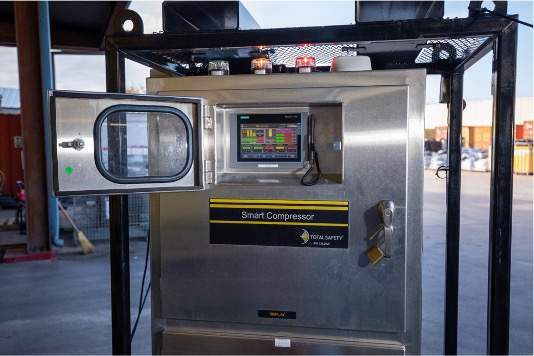Learn About Its Advantages Over Traditional Industrial Breathing Air Systems

Working in conditions where respiratory hazards exist, clean air is of vital importance. To ensure the safety of workers, employers should understand the importance of traditional breathing air systems along with other advanced capabilities. By utilizing technology such as Total Safety’s SmartCompressor®, projects can become more efficient, less costly, and workers will be equipped with clean, breathable air.
What is a Breathing Air System?
Traditional breathing air systems provide adequate quality air to workers in industrial settings with poor air quality. This system includes an air source, a compressor, air distributors, and respirators.
There are three main types of breathing systems:
-
- Constant flow – A continuous supply of air is sent through the respirator, minimizing air leakage and the entry of air contaminants.
- Demand flow – Here, individual users control the flow of air to the respirator…air enters the respirator when the user inhales. Air is provided by compressed air, either from an air cylinder or an on-line A demand flow system is ideal for projects with short time durations.
- Pressure-demand – In a pressure-demand system, airflow is continuous and increases when the user Utilizing compressed air, this system requires a tighter fitting respirator due to the increased pressure.
An operation’s size and complexity for providing clean and safe air to employees depend on many factors, including what the system’s use and how many workers will use it.
Limitations of Traditional Breathing Air Systems
As much as traditional breathing air systems do to protect a jobsite, they also generate contaminants that safety managers need to monitor.
-
- Carbon Monoxide (CO)
Typically the most common contaminant, carbon monoxide has no odor or color and is produced when fuel is burned. Carbon monoxide can enter the airline through the compressor’s air intake or when piston air compressors are overheated.
-
-
Oil
Lubricated air compressors sometimes have oil from the pistons enter the air system. Unlike carbon monoxide, oil mist has an unpleasant odor and is quite noticeable.
-
Water
Moisture from the air can enter a compressor, change to a vapor, and condense when it’s cooled. Condensation, in the helmet for instance, can cause problems for the wearer. Also, if temperatures are low enough, water can freeze and block the flow of air.
-
Solids
With the most advanced detection capabilities, Total Safety monitors breathing air closely. Throughout the world, we provide top respiratory equipment, systems, and services to help keep people safe and operations profitable.
-
Hazardous Air Quality
Hazardous air pollutants and toxins are known to cause cancer or other serious health effects. These harmful pollutants also have an adverse effect on our planet.
Examples of toxic air pollutants include:
-
- Hydrogen Sulfide
- Benzene
- Perchloroethylene
- Methylene chloride
Examples of other listed air toxins include dioxin, asbestos, toluene, and metals such as cadmium, mercury, chromium, and lead compounds.
OSHA Standards
OSHA’s breathable air regulation stipulates equipment and machines create air safe for people to inhale. It’s most critical that workers have access to manufactured air when working in chemical plants or in spaces where oxygen levels are low.
Processing, chemical and other industrial facilities need to follow OSHA standard 29 CFR 1910.134 closely because these workspaces often involve the use of harmful substances that impact air quality. Industrial breathing air systems have to meet the following chemical element requirements:
-
- Oxygen content 19.5 – 23.5 percent
- Hydrocarbon content no more than 5 milligrams per cubic meter of air
- Carbon monoxide content less than 1,000 parts per million
- A lack of noticeable odor
Due to the prevalence of harmful substances in industrial facilities, employers have to ensure employees have the proper respiratory equipment on hand. These can include personal respirators as well as larger products that produce high-volume breathing air on site. If breathable air doesn’t meet standards, employees may suffer health side-effects associated with poor air quality.
Effects of Poor Air Quality
Poor air quality in the work environment can have an impact on employee health. In fact, the Environmental Protection Agency has concluded that poor air is one of the most urgent public risks to health.
Common short-term side effects of poor air quality may include some of the following:
-
- Headaches.
- Fatigue.
- Irritation in eyes, nose, throat and lungs.
- Difficulty concentrating.
“The SmartCompressor Is A Safer, More Efficient Breathing Air Solution”
SmartCompressor
Total Safety’s innovative, exclusive high-volume, low-pressure SmartCompressor makes turnaround projects safer, more efficient, and less costly. Compared to traditional breathing systems, the SmartCompressor provides 220 cubic feet of Grade D breathing air per minute. Smart Compressors can support up to 100 people working under air continuously, from 100 feet to a quarter of a mile away, with the right respirator equipment. This breathing air system monitors air pressure, air flow, air temperature, dew point and the levels of gas detection, including O2, CO, CO2, and VOC and provides real-time breathing air analysis that is monitored 24/7 in real-by a trained operator
By utilizing Total Safety’s SmartCompressor, your operation can achieve:
-
- Increase in efficiency: no moving, refilling cascades
- Improvement in utilization: easy to use
- 24/7 automatic air monitoring supervision
- Fewer breathing air hardware requirements
- Centralization of breathing air services
- Safer working atmosphere
Quality respiratory protection is a serious concern that affects the health and wellbeing of your workforce. Employers must address these issues and provide quality breathing air solutions in order to create a safer working environment during turnaround and maintenance projects.
For more information about SmartCompressor, supplied breathing air products and other types of respiratory protection services, plus learn how to achieve higher air standards, contact Total Safety today.








